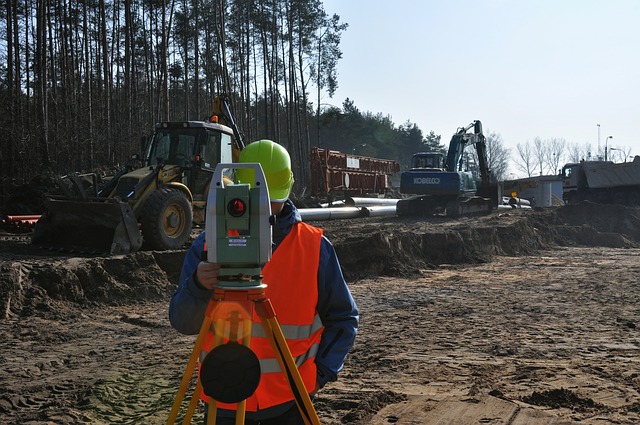Levelling in surveying
Contents |
[edit] What is levelling?
Levelling in surveying is the process of determining the height of one level relative to another. It is used to establish the elevation of a point relative to a datum, or to establish a point at a given elevation relative to a datum. This can be important when laying out or measuring buildings, other built assets and landscape.
For more information see: Levelling applications
[edit] What area the types of levelling instrument?
The main instruments used for levelling include:
- Dumpy level: Often a generic term for an optical level.
- Tilting level: Replaced by the automatic level but useful where vibration is a problem.
- Automatic level: Includes an internal pendulum which allows a horizontal reading.
- Laser level.
- Digital level: Staff read automatically.
- Water level: Useful in confined spaces.
For more information see: Surveying instruments.
[edit] How to take levels
The reticule is sometimes known as the cross-hairs or stadia hairs. The full horizontal line is the reference line for levelling and the 2 shorter lines above and below the full line are stadia lines for tacheometric measurements.
Care should be taken of staffs as well as levels as they are prone to damage. They should be inspected regularly for signs of wear. A common error is misreading the staff, so it is important that time is taken to ensure accurate readings.
The staff must be held vertical. The best ways to eliminate error are as follows:
- A small spirit level should be attached.
- Whilst standing upright the staff should be held in front with both hands down the side of the staff.
- The staff should be ‘rocked’ back and forth, and the lowest reading recorded.
- The verticality of the staff should be checked against a vertical line by standing to the side of the staff and checking it is aligned.
[edit] Booking observations
The steps to take when booking observations are as follows:
- A new job should be started on a new page of the levelling book.
- The details should be entered at the top of the page.
- All observations should be booked legibly. If a mistake is made it should be crossed out and the correct value written above it instead of overwriting figures.
- One line should be used for each position of the staff.
- There should always be an entry made in the remarks column.
- Work should be spread out appropriately.
There are two accepted methods for booking observations:
- Rise and Fall method
- Height of the Plane of Collimation method (HPC/HOC).
Neither method can be said to be more accurate than the other. Rise and Fall does have an additional check on the arithmetical reduction of the observations which makes it more popular on line levelling. The HPC method is used for setting out because one always needs to know the height of the instrument.
[edit] Related articles on Designing Buildings
Featured articles and news
RTPI leader to become new CIOB Chief Executive Officer
Dr Victoria Hills MRTPI, FICE to take over after Caroline Gumble’s departure.
Social and affordable housing, a long term plan for delivery
The “Delivering a Decade of Renewal for Social and Affordable Housing” strategy sets out future path.
A change to adoptive architecture
Effects of global weather warming on architectural detailing, material choice and human interaction.
The proposed publicly owned and backed subsidiary of Homes England, to facilitate new homes.
How big is the problem and what can we do to mitigate the effects?
Overheating guidance and tools for building designers
A number of cool guides to help with the heat.
The UK's Modern Industrial Strategy: A 10 year plan
Previous consultation criticism, current key elements and general support with some persisting reservations.
Building Safety Regulator reforms
New roles, new staff and a new fast track service pave the way for a single construction regulator.
Architectural Technologist CPDs and Communications
CIAT CPD… and how you can do it!
Cooling centres and cool spaces
Managing extreme heat in cities by directing the public to places for heat stress relief and water sources.
Winter gardens: A brief history and warm variations
Extending the season with glass in different forms and terms.
Restoring Great Yarmouth's Winter Gardens
Transforming one of the least sustainable constructions imaginable.
Construction Skills Mission Board launch sector drive
Newly formed government and industry collaboration set strategy for recruiting an additional 100,000 construction workers a year.
New Architects Code comes into effect in September 2025
ARB Architects Code of Conduct and Practice available with ongoing consultation regarding guidance.
Welsh Skills Body (Medr) launches ambitious plan
The new skills body brings together funding and regulation of tertiary education and research for the devolved nation.
Paul Gandy FCIOB announced as next CIOB President
Former Tilbury Douglas CEO takes helm.
UK Infrastructure: A 10 Year Strategy. In brief with reactions
With the National Infrastructure and Service Transformation Authority (NISTA).
























Comments
[edit] To make a comment about this article, click 'Add a comment' above. Separate your comments from any existing comments by inserting a horizontal line.
Levelling is usually performed with an automatic level and graduated staff rather than the total station in the picture.
This is a wiki site - so if you are unhappy with something, just click 'Edit this article' at the top of the page and change it.